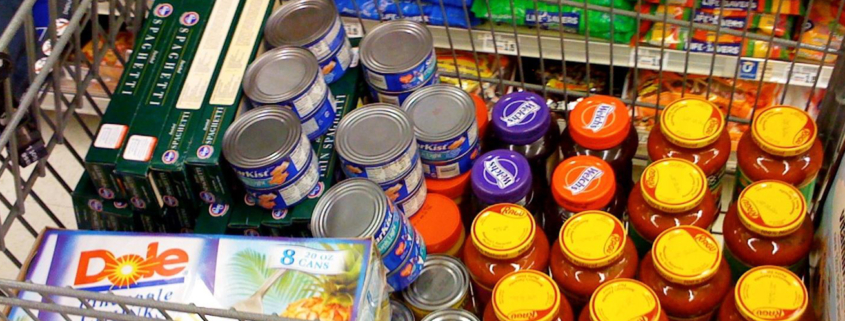Cut Your Grocery Bill in Half Using this Shopping Method
Food prices in the U.S. have climbed so dramatically over the past year, a stroll through the aisles of a typical supermarket is enough to kill your appetite. If that were the only place we spent our food dollars that would be one thing. But most families these days spend as much eating out as they do for food to prepare at home.
The Jarring Truth
It’s no secret that supermarkets and grocery stores purposely design their layouts to entice us to buy more than we’d planned to purchase when we walked through the door, but shoppers are not victims. It all boils down to our choices—not just for what we buy but when we buy it.
There must be dozens of ways to shop for groceries, and I’m confident I’ve tried them all. But when it comes right down to it, every possible method falls into one of two categories—1) needs shopping or 2) reserve shopping.
Needs Shopping
You buy what you need now at the best price possible and enough to last until you go shopping again.
Needs shoppers are frequent shoppers. They’re meal planners and make shopping lists. They keep their eyes open for sales, frequently opting for the best price rather than specific brands for the items they need.
Reserve Shopping
As a reserve shopper, you buy what’s on sale even if you don’t need it now so that you won’t have to pay full price for it when you do need it.
Reserve shopping is the process of building a small in-house grocery store. When it’s time to make dinner, you visit your own store.
Gratefully, years ago I learned to be a reserve shopper, thanks to Teri Gault, founder of The Grocery Game. I credit this method with a rather large stockpile of food and household supplies that has allowed me and my family to sail through surprising food shortages and disappearing household supplies. Unless you’ve been living on another planet, you know what I’m talking about.
Let’s just say that my deep pantry (as opposed to the small pantry in my kitchen) has not been fazed. We have not had a shortage of anything in the past three years, including toilet tissue and all manner of sanitizers. Items we used from the deep pantry are starting to go on sale again, and you can bet that as they do, I’m reserve shopping to replace and replenish.
Flawed Method
Needs shopping is, in my opinion, a flawed system. Even the most diligent needs shopper who shops with cash builds the week’s menus around what’s on sale, and is careful to avoid all impulsive purchases—will eventually need something that is not on sale. That’s what food stores count on. When you pay the regular full price for some of the items in your cart, the store’s plan works. They win. Mission accomplished.
How Needs Shopping Works
Consider this needs-shopping dilemma: You need mayonnaise. Your preferred brand is $6.29 for 30 oz. You need it, can’t stand the store brand, hate paying full price—but you grab it, kicking yourself all the way to the check-out.
Four weeks ago, at the high-priced supermarket across town where they do crazy things like BOGO (buy one get one free) and loss leaders below cost that are so cheap they get unsuspecting shoppers through the door—the 30 oz. size of Hellman’s mayonnaise (aka Best Foods, the Cadillac of mayonnaise among those who rate their condiments), was on sale: 3/$6. Two weeks earlier there was a $.75 manufacturer’s coupon for Hellman’s in that store’s weekly flyer!
Here’s how that deal would have played out had you been aware of the sale, clipped, and held that all-important coupon: $2.00 for one quart, less $.75 for the coupon. Final price for the 30 oz. Hellman’s: $1.25.
That beats even the store-brand price ($3.99) by a country mile! And had you been diligent in getting a couple of those $.75 coupons when available, you could have duplicated the $1.25 final price a few times and been well-stocked until Hellman’s goes on sale again.
Needs Shopping Dilemma
As a needs shopper, here’s your dilemma: You didn’t need mayonnaise a month ago. You need it now. You have no coupon, the sale is over. So you pay $6.59 for the mayonnaise because that’s the price you need it.
Half the Price
The goal of a reserve shopper is never to pay full price for anything. It’s possible and if you are diligent, eventually you will get there.
Reserve shopping is the best way to consistently pay half price for name-brand, high-quality groceries. This method requires a minimal investment of time and energy. It’s a reliable system—you can count on it to work for you week after week. You will enjoy a wide variety of foods in all food groups, including meat, produce, dairy; household cleaning products, and personal care items.
Sales Cycles
As a reserve shopper, you look to the store’s sales cycles to determine your food purchases rather than coming up with menus before you go shopping.
Here’s a hint: Most every supermarket in the U.S. works on a 12-week sales cycle. That means once every three months, something in every aisle and department of that store will be on sale—not every brand perhaps, but a brand that is well-known and popular. And when it does, you buy it, putting it in reserve even if you do not need it now. When you need to prepare a meal, you go shopping in your own reserve grocery stockpile.
The Ideal Method
Reserve shopping is an ideal grocery method for singles, families with kids, big families, little families, seniors with no kids—for all situations. You are not locked into narrow selections but have lots of freedom to choose the foods you want to buy. The amount of food is limited by the amount of money you wish to spend—not the number of meals you must prepare between now and your next shopping trip. You simply spend up to that limit and stop.
Always prepared
Eventually, you will have a month’s worth of basic groceries on hand. It will just happen as you are diligent in buying what’s on sale, and enough of it until it goes on sale the next time. This insulates you against wild price fluctuations at the grocery store. You won’t find yourself running to the store for one or two things, forced to pay the highly inflated full price.
When challenges come your way—you lose your job or get sick; there’s a blizzard; you’re hit with unexpected car repairs, even a global pandemic—whatever the setback, with food in the pantry, hard times are less hard.
More …
- 5 Breakthrough Secrets to Cut Your Grocery Bill in Half Now
- 24 Ways to Chop Your Grocery Bill
- Frugal Food and Grocery Shopping 101
















I know all about reserve shopping and how it should theoretically save so much money. I get that.
It still seems impractical to me:
#1 I don’t have time to keep up on sales and check out all the grocery stores and all their prices for everything. It wouldn’t be enough return for the time I would spend. I just shop at the cheapest grocery store in my area.
#2 Coupons are great and all, but you can’t just get a coupon. You either need a coupon app or something.
Oh, how I miss The Grocery Game. I haven’t kept as nice of a stockpile since it folded because I haven’t found a program as good. Combine that with fewer coupons being printed and Giant Eagle discontinuing their doubling coupons years ago, and I’ve become more of a needs shopper. I do comparison shop by using online ads, and I use my Walmart app to scan the bar codes at Marc’s, our discount store in town that carries almost all name brand items and who tends to have the cheapest prices compared to our grocery stores, to see which of the 2 stores has the best prices. The Grocery Game saved me so much time! I wish someone would start a similar program. Hint, hint, Mary! 🙂
I am still in touch with Teri, and I’m going to share you comment with her. It will warm her heart 🙂 Her website and software were amazing, however it’s the principles and guidelines behind all of that, that powered The Grocery Game. We can still use that in a manual way. While couponing has certainly changed (going digital), the underlying truth remains: 12-week sale cycles!
I’ve found that using my food saver when I find a sale esp a couple of weeks ago I saw some meatballs and vegeie burgers on sale I stopped and got them as soon I could..and now I have them when I’m running low on food I step into my freezer and take some out and away I go to prepare sum ahead of time so my meals are always staying ahead of the sales…and so I treat my food saver as my friend that really helps me to save save save….
I use a food saver that makes it easy to make the food that I freeze last a lot longer than normal.
and growing up in the 60s, dad taught us to be prepared….so we learned, depending on sales and our cash, buy two, put one back…so you always have a spare…thru the years, I still do it, and if something is on sale and I can afford, I’ll buy more of it….yep the foodsaver has saved me tons too! I love it! I seal up flour, sugar, dry ingredients, paperwork, all kinds of things, just wore my old one out and bought a new one on sale!
I agree. I follow blogs and stock up whenever possible. I even use my amazon cash from surveys on sale items that the blogs put out. Even though it is free I still only buy on sale whenever possible. Hip2Save and KrogerKrazy are my go to blogs. I haven’t paid for toothpaste in years. Free after coupons. LOL
Only two go-to blogs? Hmmm … 😉
How do you keep the husband (or the kids!) from treating the reserve as their own private food stash? Or from saying, “Well we have plenty so I’ll just eat some more/waste some”?
I know exactly you’re talking about! And my solution is to create an appearance of scarcity. Don’t allow your stash to be easily accessible. That might mean packing nonperishables in boxes and taping them shut. Or keeping breakfast cereals, canned good, etc. etc. under beds or on high shelves that are out of easy-reach. Motto: Out of sight, out of mind. Think about it. If your bathroom is stocked with rolls of toilet tissue out in the open, it’s human nature to use it with abandon. But if you sit down and see precious little left on the ONLY ROLL IN THE HOUSE (haha, you want to make it seem like this), most people (even children) will go easy. They don’t have to know you have a year’s worth in the garage on a high shelf in an unmarked box 🙂
I am a Reserve Shopper. It was much harder to be a Reserve Shopper when my husband and I were young and broke but, even so, I still managed to put a thing or two aside when I had a few extra pennies. I now have, in my 60s, what my daughter fondly refers to as “Mom’s bunker”. When Covid first hit the news cycles and we heard rumbling about possible supply chain issues, I made it my business to further stock up on items that were likely to become hard to come by. I watched for sales and bought extra of many, many things. I likely won’t have to purchase toilet paper, for example, until some time in 2024, lol! I was looking at not only supply chain issues but the expected price increases that I knew would occur even after supply chains were reestablished. My family appreciates my foresight. So does my wallet.
I always keep a big stash of dried bags of all kinds of beans including black beans. lentils and dried peas on hand. MIxed with last Summer’s garden tomatoes, asparagus, zucchini, and squash (from the freezer) and spices cooked in an instant pot, I can eat on this for a week. My husband is pickier than me, however. I try and eat OMAD (one meal a day) and this is also helpful. I think shopping the sales, as you have said, Mary, and skipping a few meals, here and there, is not only healthy for our pocketbooks but for our waistlines! 🙂
I do both. We have an upright freezer and a shelving unit in our basement which I stock. But I also “needs” shop since our menus are not necessarily on repeat. We love all types of ethnic foods and love trying new recipes. I have found lower priced ingredients atIndian, Oriental or Hispanic, etc. food stores.
Good tip at the end!